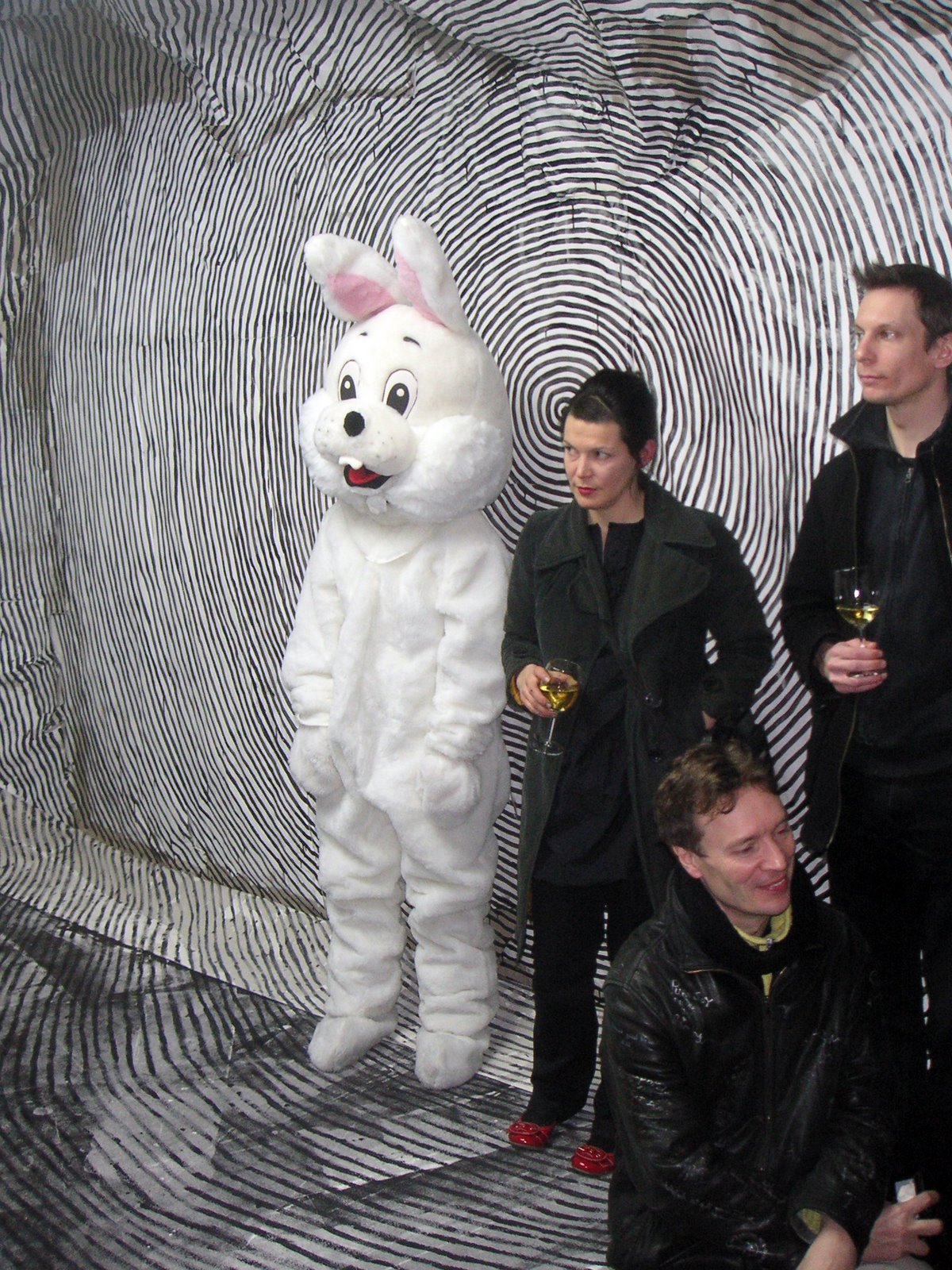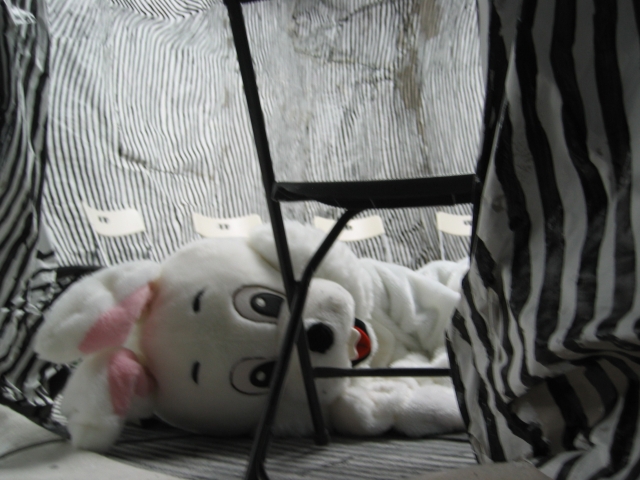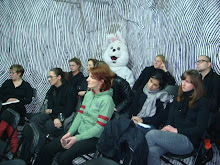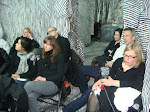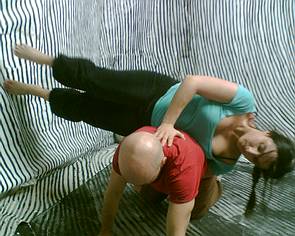VERTIGO 16 February - 05 April 2008
CHRISTL MUDRAK
Zone II (installational painting)
Christl Mudrak, Zone, 2007, installational painting, acrylic paint and dispersion on paper, plastic foil and carpet, 7 x 2.8 x 3 m (detail)
PROGRAMME OVERVIEW
*Thursday, February 21, 2008, 7 pm
FIELD Discourse lab
“Vertigo – a phenomenon in art and science”
Participants:
Dr. Michael von Brevern (neurologist)
Dr. Thomas Götz (psychiatrist)
Andreas Hiepko (freelance philologist)
Dr. Jeannot Simmen (art historian)
Christl Mudrak (artist)
Free admission, held in German
*Thursday, March 13, 2008, 7:30 pm – 9 pm
FIELD Workshop
„The body an instrument of perception – introduction to the Grinberg method”
Andreas Brieschke (Grinberg method instructor)
Admission fee: 8 €, reduced 5 €, RSVP music:
*Monday, March 31 – Tuesday, April 01, 8 pm
FIELD Performance
Dance performance: “Balanced Disorder”, direction: Carolina Varassi Pega dance: Carolina Varassi Pega, Davide Sportelli music: Gerardo Agnese video: Kathleen Kunath
Admission fee: 4 €, reduced 3 €
*Saturday, April 05, 2008, 8 pm
FIELD Closing event
Destruction – Party: The room installation by Christl Mudrak will be taken apart and taken home by the visitors.
***
VERTIGO
Vertigo is a sensation everyone has experienced at some point. Be it after a ride in a carousel, following childhood games like “rolling down a hill” or “spinning around one’s axis”, after standing up all-too abruptly, or having ventured to climb into staggering heights. Fundamental to all these occasions is the act of exposing one’s body to something that literally turns the accustomed order of things up side down. Top and bottom are reversed and we are thrown into a different perceptive state. Our mind is shut off; all control is left to the unconscious.
The state of vertigo is often employed in spiritual rituals. Sufis for example, better known as Dervishes, spin around their body axis during the sema (trance dance) in order to purposely gain a transcendental state.
Besides being an experience associated with pleasure or spirituality, vertigo can become frightening when loss of control is not intended, but occurs due to physical or psychological disorders. Different branches of medical research are dedicated to studying the various pathologies which can elicit vertigo. Thus it is not uncommon for a vertigo patient to consult an otolaryngologist, a neurologist, an orthopaedist, and a psychiatrist before he/she can receive a conclusive diagnosis.
For the project VERTIGO, which marks Christl Mudrak’s first solo-exhibition, she has developed a site-specific, installational painting, called Zone.
The artist wraps the entire space in paper, creating an amorphous structure, which she subsequently covers with room-encompassing spirals. These spirals, applied with a paint brush and black paint, irritate the viewer’s sense of space and balance.
The room has lost its comprehensible form, that otherwise provides orientation. Mediated by visual perception, a bodily response is brought about which inevitably influences the viewer’s emotional state, but is based on physical rules and physiological mechanisms.
One could speak of an emotion-evoking space that causes a feedback effect which refuses any judgments about subject and object, inside and outside, activity and passivity, true or false. As in a dream, the beholder drifts through an unfamiliar space, in which the impossible becomes likely, and entirely new dimensions of thought are revealed.
***
Christl Mudrak graduated from the Kunsthochschule Berlin-Weißensee in 2006 as a master student of Katharina Grosse. At the time, she is studying in the MFA-programme at Goldsmith College in London. She has participated in numerous group exhibitions, most recently in January 2008 at Arti et Amicitiae in Amsterdam, and is one of the finalists for the Celeste Art Prize 2008.
For the term 2007/08 she has accepted a teaching activity at the Eidgenössische Technische Hochschule (ETH), Zurich.
***
DETAILED PROGRAMME
FIELD Discourse lab
“Vertigo – a phenomenon in art and science”
The initiation of a dialogue between art and science is at the heart of FIELD’s discourse labs. They bring together scientists and practitioners from different disciplines and artists from different branches. On the premises of the project space an immediate exchange is sought in the midst and on the basis of the art work. Aesthetic aspects are confronted with aspects from the natural and cultural sciences.
What is Vertigo?
A question that provokes different answers depending on the scientific discipline asked, and even then remains difficult to grasp, is the topic of FIELD’s third discourse lab “Vertigo – a phenomenon in art and science”. FIELD consciously chose a focus on the medical and cultural sciences.
The discourse will be based on the site-specific installation Zone by Christl Mudrak, a room full of spirals, which creates its own universe, dissolving accustomed conceptions of space and eliciting a certain feeling of vertigo.
In medicine, vertigo is a symptom with various causes. In order to gain a diagnosis, it is often necessary to consult a series of different experts. What is actually happening within the body depends on the type of vertigo experienced. But what is it that elicits vertigo? Is the origin mainly of somatic or psychological nature? And how does this relate to the installation Zone by Christl Mudrak?
Now, we don’t only encounter vertigo in medicine, but increasingly frequently in everyday life due to a communication and amusement industry that is constantly gaining in rapidity. Vertigo is received ambivalently, having potential to evoke pleasant as well as unpleasant feelings. But wherein lies the attractiveness of delirium, or asked differently, the fear of it?
Culturally and art historically the discussion of vertigo offers many points of reference, be it its use in ritual dances in order to reach transcendental states, Marcel Duchamp’s and Op art’s explicit work with spirals, or to reference probably most people’s first association with vertigo, the cinematographic classic of the same name, where the bodily phenomenon of vertigo is mixed with fraudulent swindle.
FIELD would like to get to the bottom of following questions in the course of the discourse lab:
How can we characterize the relationship between art and medicine with regard to Christl Mudrak’s work? How is the phenomenon treated in art? By which means are experiences of vertigo made perceivable or actually elicited in the beholder by the arts, be it the visual arts, literature, video/film, or dance? And wherein lies the attractiveness on the one hand and the fear on the other of losing control?
Participants:
Dr. Michael von Brevern (neurologist, specialized research on vertigo diseases; Parkklinik Weißensee, Berlin)
Dr. Thomas Götz (psychiatrist, Ambulance for bipolar disorders, clinic for psychiatry and psychotherapy, Universitätsklinikum Carl Gustav Carus Dresden, TU Dresden)
Andreas Hiepko (freelance philologist)
Dr. Jeannot Simmen (art historian, curator, author, e.g. of “Vertigo – Schwindel in der modernen Kunst”, director of Club Bel Etage)
Christl Mudrak (artist)
Date: Thursday, February 21, 7 pm
Free admission
FIELD Workshop
“The body as an instrument of perception – an introduction to the Grinberg Method” – Andreas Brieschke
Christl Mudrak’s installation brings about a whole-bodily reaction by means of a visual stimulus and evokes emotions which are beyond the viewer’s control. The latter involuntarily gives him/herself over to an unsecured, floating state, and momentarily loses control over body and mind.
The Grinberg Method utilises this same effect. Using a primarily bodily access, it tries to achieve an in-depth change and a heightened body-perception in the client. As a type of self-protection mechanism we develop an automated behaviour which suggests that we are entering a secure space, whereby a more adequate behaviour may be suppressed. By applying touch and certain exercises, the Grinberg Method trains people to perceive themselves as bodies and utilise resources to dare new things.
Andreas Brieschke, licensed instructor of the Grinberg Method, will lead a workshop in which he will introduce the audience to practices of the method. Special focus will be on the act of perception, for which he will illustrate the idea of the Grinberg Method with some exemplary exercises.
Date: Thursday, March 13, 7:30 pm – 9 pm
Admission fee: 8 €, reduced 5 €, RSVP
FIELD Performance
Dance performance: “Balanced Disorder”, direction: Carolina Varassi Pega dance: Carolina Varassi Pega, Davide Sportelli music: Gerardo Agnese video: Kathleen Kunath
Christl Mudrak gives us an example for how vertigo can be elicited through painting. Working with the effect produced by the installation, the Argentinean choreographer and dancer, Carolina Varassi Pega, will develop a dance performance inside the installation together with other dancers and musicians.
The initial question of this work-in-progress will be which consequences the disturbed perceptive state has on the body, its movement and coordination in space. Basis of the work will be experimentation and improvisation.
“We will try to create living moments of intersection between the scenery, the music, the images, the physicality, and the public”
Carolina Varassi Pega graduated as a stage dancer from the Folkwang Hochschule in Essen (lead by Pina Bausch) in 2003. As a professional dancer she has already worked with many renowned choreographers and companies, among them Juan Cruz de Garaio Esnaola (Sasha Waltz & Guests), La Fura del Baus (“Die Zauberflöte”, Opera Bastille) and Felix Ruckert. She lives and works in Berlin.
Date: Monday, March 31; Tuesday, April 1, 8 pm
Admission fee: 4 €, reduced 3 €
FIELD Closing event
Destruction – Party
Have you always dreamed of destroying a work of art? Then this is your one-of-a-lifetime chance at our Closing – Event – Destruction – Party.
The finale of the exhibition will be a collective destruction of the installation. This will become a symbolic act for the transience of a temporal, site-specific art work.
The party guests may remove a part of the work themselves and subsequently purchase it. Like at a home improvement store, the price will depend on square meters.
FIELD invites to a big happening: iconoclasm – running riot explicitly welcome!
Date: Saturday, March 29, 8 pm
Free admission



